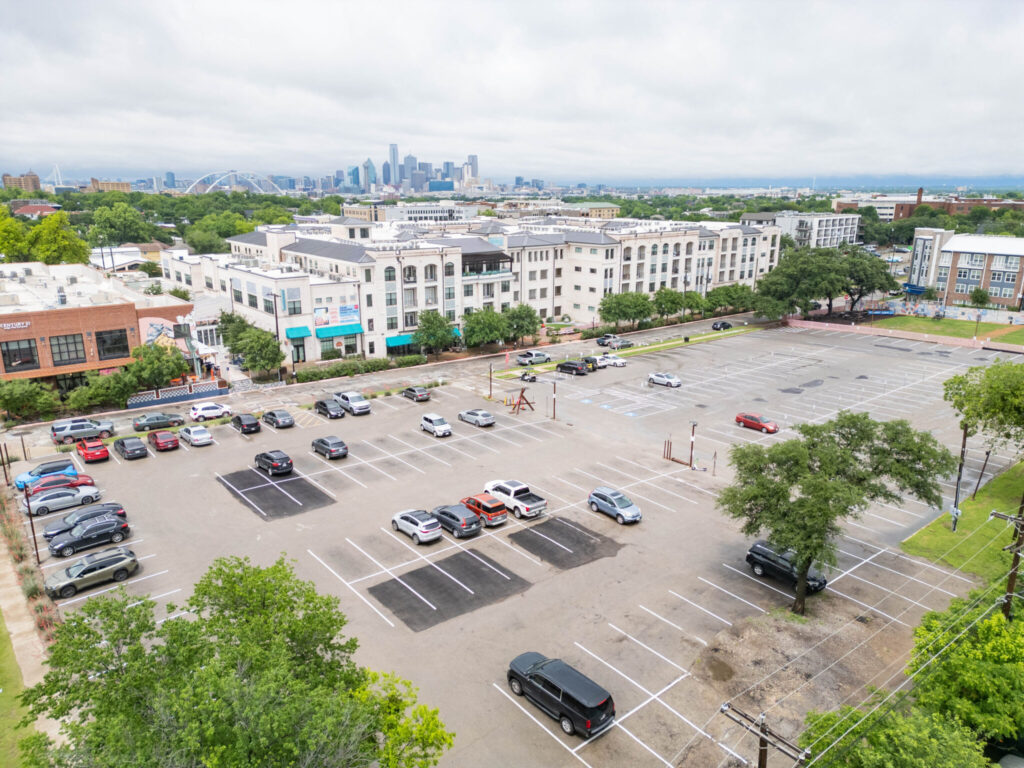After years of discussion, city council approved parking reform for Dallas on May 14.
Chapters 51 and 51A of the Dallas City Code determine parking areas’ location, design and how much off-street parking must exist per land use. These regulations impact housing affordability, economic development potential, environmental resiliency, safety and walkability in Dallas. Amendments are being considered which would shift the approach from one-size-fits-all numerical requirements to a framework prioritizing context-sensitive travel demand management, multi-modal transportation options and well-designed parking facilities.
The reform looks to dismantle strict parking mandates to allow for more housing and small business opportunities. Jake Ettinger, District 1 policy advisor and community liaison, says the parking reform will primarily help small businesses.
“A big business can afford to buy a plot next to it, build a parking garage, or just pave, and a small business can’t afford to do that,” Ettinger says. “I think something that’s really unique about Oak Cliff is we have all these amazing women and minority owned small businesses, and so if we want to support them and make it easier for future small businesses to come in, this is really going to be a huge step in the right direction.”
Restaurants and bars, particularly those under 2,500 square feet, could see mandates completely waived. For buildings over 2,500 square feet, one space per 200 square feet for sales and seating area would be required.
Parking requirements are recommended to be removed for office use and Downtown, with no parking for any use within 1/2 mile of light rail, streetcar stations and Downtown districts. According to the proposal, parking minimums would also be reduced for hotels, commercial amusement and places of worship, with designated historic buildings having minimums mostly removed.
The idea for parking reform originated in District 1, when a boutique hotel was looking to open on Beckley Avenue.
The 12-room hotel was wanting to build on a 2,500 square foot restaurant and connect everything with a patio. “It was a very fun, kind of funky plan, from what I saw, and the location is what caused the problems,” District 1 council member Chad West says. The developer was going to have to park it to code, and the parking require- ments were going to be 12 spots — one space for each hotel room, plus they had to completely park the restaurant because it wasn’t connected to the hotel, totalling 37 parking spaces.
“City staff got it, and they were recommending massive reductions in parking,” West says. “But in the time it took for all of this to happen … some individuals had gone into that building and lit a fire in it and burned it down.”
This instance inspired West to look into the outdated parking code.
“It started with a simple memo asking the plan commission to look at it. And once I sent that memo, my plan commissioner at the time, Enrique MacGregor, and two other commissioners, filed a three-signature memo to make it official at the plan commission level,” West says. “We want to get away from just doing a PD for every single situation and try to fix this globally to benefit businesses and not put the burden on them to try to figure out what they’re supposed to be doing.”
In addition to the hotel, other Dallas businesses have been impacted by parking requirements. Val’s Cheesecake in East Dallas had growth stopped by two parking spots and permit confusion — they needed two more parking spots, eight total, to apply for a certificate of occupancy that allows customers to enjoy their purchases inside the shop. B-Side Coffee, now Little Joy Coffee, in Elmwood has also had its struggles.
“B-Side coffee, but that entire building in Elmwood, has had a lot of turnover in tenants … and has really struggled to
keep a tenant long-term because they’re so limited by the parking requirements,” Ettinger says. “There’s all these neighbors that live in Elmwood and just want to walk over to their morning coffee shop. But it’s the parking requirements that say, ‘Hey, no, you need this many parking spots.’”
Additionally, Ettinger says this could make housing more affordable in the city, as part of the cost of housing right now is unused parking spots. Multi-family dwellings will see a decrease in parking requirements from one space per bedroom to one-half space per unit.
Other council members, such as District 10’s Kathy Stewart, do not agree with all aspects of the proposed parking reform.
“From a multi-family perspective, what came out of CPC (City Plan and Zoning Commission) was the one-half space per unit, and I just don’t think that works in District 10 or in District 12,” Stewart says. “We have a lot of multi-family that is adjacent to single-family, and we already have examples of where property managers put some impediments of some things in the way of people parking multiple cars, like they’ll charge an extra fee for your second car.”
In some cases, residents opt out of parking in the parking facility, and they go to park on the public streets in the single family neighborhoods, Stewart says. This can be disruptive to people who live on those streets.
“I really had preferred that they roll this out in the center of the city, right where there is a lot of density already, and where parking has been an issue, and then sort of bring it in in phases,” Stewart says. “We couldn’t really get agreement on that. I’ll just say everybody was more or less ready to roll it out citywide, and they were willing to make some concessions on multifamily, which, again, was my biggest hiccup.”
Currently, the city requires one parking spot per bedroom. Ettinger says this doesn’t always make sense for multifamily housing.
“If you have two young kids that don’t have a car, why do they need a parking spot?” Ettinger says. “As a city, big picture when we think about what housing is going to look like, 10, 20, 30 years from now, if we want families to not just be confined to single family homes, but also have the option if they want to live in townhouses or multi family that’s well designed, we’re going to need this.”






